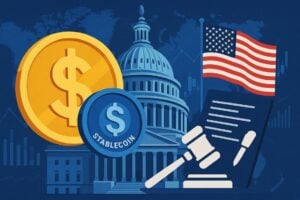The discussions on US Stablecoins are gaining prominence in the American political and economic debate, especially as the dollar faces new pressures regarding its role as the world’s reserve currency.
During a Senate hearing, Scott Bessent, the Treasury Secretary, emphasized how, throughout history, there have been numerous moments when the decline of the dollar was feared.
Yet today, the advent of digital stablecoins reignites the confrontation between financial innovation and the primacy of the dollar in the global economy.
The evolution of US Stablecoins and their financial impact
The US Stablecoins are digital assets pegged to the dollar, designed to maintain a stable parity with the US currency. This makes them revolutionary tools for transferring value globally.
However, their exponential growth is raising crucial issues for US policymakers regarding control and financial sovereignty.
According to Bessent, the history of the dollar as a reserve currency is marked by phases of skepticism and fears of decline. Yet, factors such as confidence in US markets and institutional solidity have always confirmed the dollar’s primacy.
Today, the emergence of stablecoins represents both an opportunity to strengthen the international role of the dollar and a threat if their regulation escapes control.
Bessent addressed the concerns of Congress regarding the growing adoption of stablecoins. Some senators see these assets as a strategic lever to further strengthen the global dominance of the dollar, allowing for fast and secure digital transactions.
Others raise significant doubts in terms of financial stability and potential money laundering risks.
Divergent opinions translate into a complex legislative path. On one hand, there is pressure to quickly define a clear regulatory framework that can support innovation and protect U.S. interests.
On the other hand, some legislators are pushing for greater guarantees on the reserves to cover stablecoins and for effective control tools against illicit uses.
The Treasury Secretary openly acknowledges that the strategic goal of the United States is to maintain the leadership of the dollar in global finance, even in the digital era.
In this sense, Bessent emphasizes the need to quickly adapt American financial policies, creating modern regulatory tools that allow the dollar to remain at the center of the regulated cryptocurrency ecosystem.
The debate on the regulation of stablecoins is therefore part of a broader reflection on the role of the dollar as a reserve currency.
According to Bessent, financial innovation offers unique opportunities: leveraging these emerging technologies could consolidate the position of the dollar. In the absence of effective rules, however, stablecoins risk eroding international trust in the U.S. financial system.
The regulatory challenges for US Stablecoins
One of the main difficulties concerns ensuring that stablecoins are actually backed by real reserves in dollars or other safe assets.
According to several senators, transparency on reserves is crucial to avoid systemic risks and to prevent stablecoins from destabilizing the entire global financial system.
Furthermore, the possibility that unregulated actors may issue stablecoins threatens the foundations of the current system.
Despite the enthusiasm for the revolutionary potential of these technologies, there remains a need to structure rigorous supervision in order to defend the monetary sovereignty of the USA.
During the hearing at the Senate, Bessent repeatedly referred to the recurring cycles in the history of the American currency. Every major geopolitical or economic crisis has fueled doubts about the dollar’s ability to maintain its dominant role.
However, the stability of the American system, according to the Secretary, has always allowed for a recovery of confidence on a global level.
Now, with the digitization of finance, the stakes are rising. Dollar-pegged stablecoins could expand the reach of the US currency even in areas traditionally excluded from banking services.
However, to succeed in this goal, it is essential that American authorities impose uniform standards of transparency and security, as hoped for by Congress.
Unlike stablecoins, Bitcoin is not tied to a specific currency and is often seen as an alternative reserve instrument.
However, the interest of Congress and the Treasury Department is increasingly focusing on stablecoins, considered strategic for defending the primacy of the dollar in a phase of great technological transformation.
The voice of the Treasury: political guide and future prospects
The prospects for US stablecoins therefore remain tied to the ability of the American system to adapt to new digital balances.
The Treasury, led by Bessent, reiterates that international trust in the dollar depends on the solidity of institutions and the effectiveness of rules to protect investors and consumers.
In the new scenario, promoting clear regulatory criteria for stablecoins is not just an economic issue: it is a geopolitical imperative.
- Digital innovation: fast and secure management of global transactions.
- Transparent reserves: need for rigorous verification mechanisms.
- Financial sovereignty: defense of the primacy of the dollar beyond national borders.
- Institutional collaboration: central role of government and Congresses in defining the rules of the game.
The emergence of US stablecoins places the American financial system before a fundamental strategic choice. To leverage innovation to expand the global dominance of the dollar or risk losing ground to new instruments without regulation.
Bessent’s words, during the recent Senate hearing, indicate the path to follow: strengthening international trust through clear, transparent, and future-oriented rules.
For those operating in the financial sector and for policy makers, this transition represents a unique opportunity.
Staying informed and participating in the debate will be essential to support the leadership of the dollar and drive the digital transformation of global finance.
The challenge of stablecoins, today more than ever, is played on trust, transparency, and the ability to adapt to new international scenarios.







